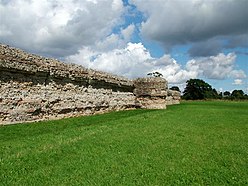Gariannonum, or Gariannum, was a Roman Saxon Shore fort in Norfolk, England. The Notitia Dignitatum, a Roman Army "order of battle" from about AD 400, lists nine forts of the Saxon Shore in south and east England, among which one was called Gariannonor. It has been much discussed over the years in terms of spelling (Gariannonum, Garianonum, Gariannum), purpose (whether it really was intended for defence against Saxon raids), and location (whether it was Burgh Castle or the Caister-on-Sea site).[1][2] The fort is listed as being commanded by the Praepositus equitum stablesianorum, implying its garrison was a cavalry of a form originated in the late 3rd century, the Equites Stablesiani.[3] Both proposed sites show archaeological evidence for military occupation beginning at around the time this type of unit began use.[4][5]
| Gariannonum | |
|---|---|
 Burgh Castle is usually identified as Gariannonum | |
Location in Norfolk | |
| Alternative name(s) | Gariannum |
| Location | |
| Coordinates | 52°34′55″N 1°39′07″E / 52.582°N 1.652°E |
| County | Norfolk |
| Country | England |
| Reference | |
| UK-OSNG reference | TG474045 |
The name Gariannonum is thought to derive from a river-name, Gariennus, mentioned in Ptolemy's Geography. This is thought to derive in turn from a Celtic root meaning "babbling river", which may refer to the River Yare, although much uncertainty remains.[2][6]
Identification edit
The situation of Gariannonum has usually been identified as either Burgh Castle, which lies on the River Waveney just before its confluence with the River Yare, or the Roman fort at Caister-on-Sea, 9 kilometres (5.6 mi) away at the mouth of the River Bure. In Roman times, both sites lay on opposite shores of a large estuary (the remnant of which is Breydon Water).[7] The earliest proposal for its identity, made by the antiquary William Camden in the first edition of his Britannia in 1586, is that Caister was its location;[4] but in his fifth edition of 1600 he changes his mind and suggests that Burgh Castle is the more likely.[8] For centuries, little evidence could be brought to bear, and historians presented opposing views.[9] While the remaining walls at Burgh Castle are clearly consistent with a late Roman fort, the military function of Caister-on-Sea was more open to doubt.[10] A modern reassessment of the Roman settlement at Caister-on-Sea has shown that it too had a military function.[11] The identification of Burgh Castle as Gariannonum is uncertain, and the name could apply to Caister-on-Sea.[11][12] Archaeological evidence from excavations of the sites in the 1950s indicates that both were similarly occupied for military use in the 4th century, giving rise to the suggestion[4] that the two forts together were considered as one site guarding the entire Yare estuary, with the name Gariannonum originally applied to the Caister site and then expanded when the second fort was built at the Burgh site.[13]
References edit
- ^ "Pastscape website article: Burgh Castle". Retrieved 7 May 2011.
- ^ a b Rivet, A. L. F.; Smith, Colin (1979). The Place-Names of Roman Britain. London: Batsford. pp. 366–67. ISBN 0691039534.
- ^ Polemius Silvius; Seeck, Otto, ed (1876). Notitia dignitatum; accedunt Notitia urbis Constantinopolitanae et laterculi prouinciarum. Berolini, apud Weidmannos. p. 181.
{{cite book}}:|author=has generic name (help)CS1 maint: multiple names: authors list (link) - ^ a b c M. J. Darling and D. Gurney (1993). Caister-on-Sea: Excavations by Charles Green 1951–55. East Anglian Archaeology.
- ^ Johnson, S. C. (1983). Burgh Castle: excavation by Charles Green, 1958–61. East Anglian Archaeology.
- ^ Jacek Fisiak, Peter Trudgill, (2001), East Anglian English, page 40. Boydell & Brewer
- ^ Nic Fields, (2006), Rome's Saxon shore: coastal defences of Roman Britain, AD 250–500, page 28. Osprey
- ^ Camden, William (1610). Holland, Philemon (ed.). Britannia (7th ed.). London.
- ^ See Henry Swinden, (1772), The History and Antiquities of the Ancient Burgh of Great Yarmouth in the County of Norfolk, page 2: "But where that ancient fortress was situated, authors are not agreed. The generality, with Camden, place it at Burgh-Castle; while others (a), with some probability, think Caister, near Yarmouth, the Gariannonum of the Romans."
- ^ Roger Wilson, (2002), A Guide to the Roman Remains in Britain, pages 245-6. Constable
- ^ a b Andrew F. Pearson, (2003), The construction of the Saxon Shore Forts, page 10. Archaeopress doi:10.30861/9781841714875
- ^ Garianno Burgh Castle or Caister-on-sea, Suffolk Archived 2007-01-05 at the Wayback Machine, Roman Map, retrieved 18 May 2011
- ^ Burgh Castle History and Research, English Heritage - retrieved 18 May 2011
External links edit
- Burgh Castle, English Heritage
- Caister Roman Site, English Heritage
- The Great Estuary Story, Broads Authority
- Gariannum Roman Fort, Roman-Britain.co.uk
